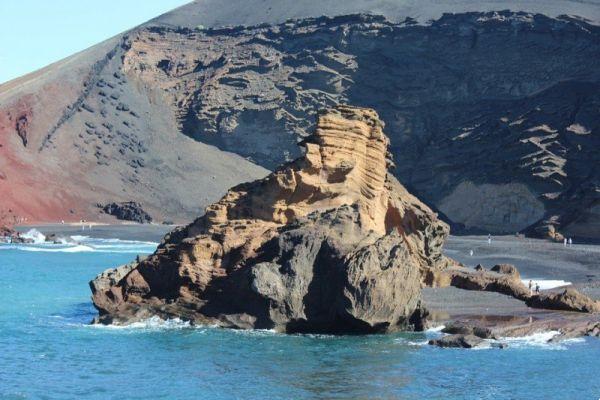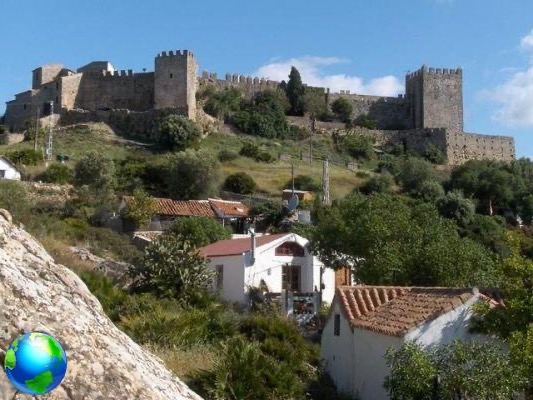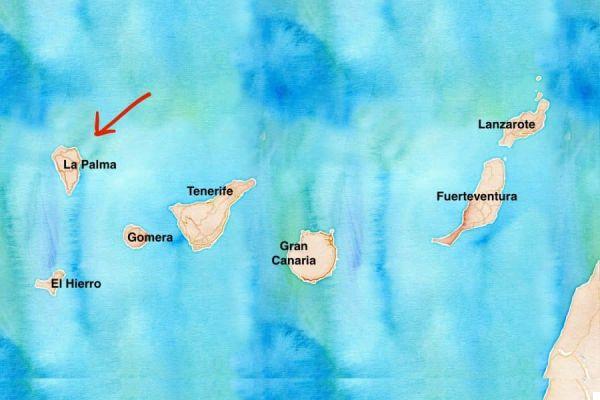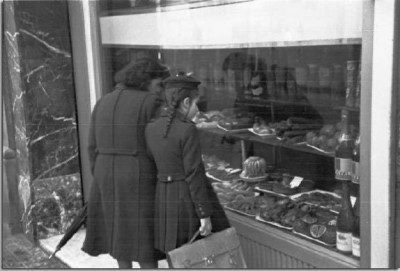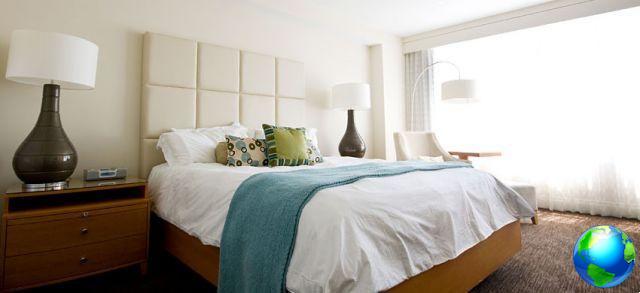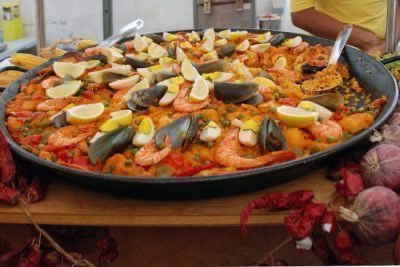After having visited La Palma , I could not fail to visit also El Hierro, the smallest island of the Canaries (if you don't consider La Graciosa, which was added only in 2018). El Hierro is also the most remote island, as well as the most southerly and westerly of all, and has remained intact from a naturalistic and cultural point of view. Like the other Canary Islands, El Hierro is also an island of volcanic origin and its landscape is characterized by wild coasts drawn by lava, laurel forests, arid lunar landscapes, natural pools and magnificent backdrops. In the 2000 El Hierro has been declared a UNESCO Biosphere Reserve and has recently achieved energy self-sufficiency (with 100% renewable energy then!). AND a decidedly green island, devoted to ecotourism and diving; being a reserve then, in El Hierro it is no longer possible to build anything, but only to renovate. Thanks to this, the island will be able to preserve its natural heritage even more and will not be defaced by any eco monsters (or similar), as has already happened for some of the other islands of the archipelago.
In Spain the island has recently received great notoriety thanks to a TV series called "El Hierro" (shot on the island of course), while it is very little known and little traveled by European tourism in general. If you are looking for a wild and uncontaminated place… this is the island for you (if you love diving… even more !!).
Health insurance is recommended
Being in Europe, as Spanish citizens we have the right to health care, but there are specific conditions and ceilings. My advice is to still take a classic medical-luggage insurance that can cover you during the trip, even for Covid-19. I am very happy with many insurance companies, a site that compares the policies of different companies and proposes the most convenient policy for that particular trip. To do this you will have to enter the data relating to your trip and they will send you an email with the best proposal that you can then buy directly online (!!!). All travel insurances also cover medical assistance in the event of a coronavirus infection, including testing if necessary. There is also coverage for the extension of the stay in the hotel due to the quarantine. Likewise, the trip cancellation guarantee includes coverage for illness or death of the traveler or a family member due to COVID-19.

When to go to El Hierro
As with the rest of the Canary Islands, too El Hierro has a subtropical climate, with long hot summers and non-existent winters, so you can always go there! Temperatures can vary between 15 ° C minimum and 20 ° C maximum during the winter, and 22 ° C minimum and 30 ° C maximum in summer. However, there are very marked differences between the different points of the island: in the north (where Valverde, the capital is located) it can rain a lot in winter, while the south (in Le Restinga) has an arid and sunny climate all year round, being protected from the trade winds that blow from the north. As for the tourist season, the high season runs from October to February (and is mainly determined by visitors from northern Europe), while summer is an intermediate season, and the island is mainly frequented by visitors from the Mainland Spain. As there are few tourist facilities, if you decide to go there in high season, book your accommodation (and car rental) in time. The period that I recommend the most is March / Aprilwhen all the fields are in bloom.
How to reach El Hierro
To reach El Hierro from Spain you will necessarily have to make a stopover in Tenerife or Gran Canaria and then take a domestic flight (operated by the company Binter Canarias). The price of the flight varies according to the season, but you can also find it at 40-50 euros (only the internal flight eh!). From the south of Tenerife you can also reach El Hierro by ferry. The Los Cristianos-Valverde route is covered by 2 companies Naviera Armas and Fred Olsen (each with 1 trip per day on average) and the ticket costs 50 euros (one way). The journey takes 2,5-3h.

Getting around in El Hierro
To get around El Hierro I definitely recommend renting a car, otherwise you will be able to see very little. Fortunately, in the Canaries it costs very little, as well as petrol. When I travel I normally use the Rentalcars website, but for El Hierro the companies with the best value for money are Cicar and Cabrera Medina, which allow you to rent a car without blocking your credit card and with Kasco without excess. The cost for a week is around 120-130 euros. The cheapest company of all, however, is Plus Car; they do not have physical offices but you will fill in an online form where you will indicate the point where you would like to start the rental and they will bring the car there. It is a little more inconvenient, but it saves a good 20-30% on the rental. Note: be prepared to drive on very beautiful but curvy roads! There are very few straights and flat roads (just like in La Palma!).
Where sleeping in El Hierro
Even if you don't intend to dive, however, I recommend that you sleep in the town of La Restinga, in the southern tip of the island. La Restinga is located in what is called the "Costa Calma", because it is very sheltered from the wind; here the sea is almost always calm, sunny days and there is always a few degrees higher than the rest of the island. Reaching the north or the center of El Hierro is not complicated, however, because the island is small and the distances are super feasible. I slept in theHotel Sur Restinga and I found myself very well.
If you are looking for a unique and exclusive experience, on the other hand, I recommend that you sleep on the coast of El Golfo, atHotel Puntagrande. This hotel entered the Guinness Book of Records because it is the smallest hotel in the world and it is a magnificent adults-only hotel (see paragraph 7).
Hotel Sur Restinga: very nice hotel on several levels that overlooks the marina. They have both rooms and studios with kitchens.


What to see in El Hierro: 10 things not to miss
1. Camino de la Llania and the laurisilva forest
The first thing to see in El Hierro, especially if you have not been to La Gomera, is the “prehistoric” forest of laurisilva. There laurel it is a type of evergreen forest that is millions of years old and is typical of the islands of Macaronesia (Azores, Canaries and Cape Verde). The wood is made up of evergreen laurels that reach 40 meters in height; these trees are very special because they seem to have a beard. Entering a laurel forest you will feel like you are entering an enchanted and fairy forest! To appreciate it in all its glory, I recommend that you follow the Camino de la Llania, a circular path that starts from the Fountain of the Llania , in the center of the island (code SL-EH1). There are actually 3 paths, of different lengths, but they are all easy and very well indicated with different colors. I did the one of intermediate length (4,2 km), which passes by Viewpoint of Fireba, and I loved it. El Hierro, together with La Gomera, preserves the most beautiful laurel forests of all.

2. El Pinar and the viewpoints of Isora and de las Playas
Going down the mountain towards the east coast you can reach the rural area of Isora, a beautiful countryside with all the flower fields (especially if you come in March / April). Not far away there are two very beautiful miradors of El Hierro: the Isora viewpoint and Viewpoint of the Beaches. The first is perched on the ridge of the Risco de los Herrenos, at 800 meters above sea level, and you can see the entire coast of Las Playas. If you like walking, you can also walk down from here to Las Playas by following the path PR-EH3 (3,8 km). He Viewpoint of the Beaches it is located a few kilometers further south and offers a spectacular view of the expanse of pine trees that descend towards the valley. At the time of writing, both miradors would be officially closed, but there are effectively no barriers, so you can reach them.


3.La Restinga: diving and natural pools
Among the things to do in El Hierro there is definitely diving and the best place to do it on the island is definitely La Restinga. This small fishing village overlooks the Sea of Calms (Mare della Calma), in the extreme south of the island, and so called because it is protected from the trade winds that blow from the north (the sea water is warm here too). Much of the Mar de las Calmas is also protected by a marine reserve and you can see many fish such as groupers, moray eels, rays, manta rays, some types of sharks (seasonal only) and the very particular gardener eel. I have done diving with the company Arrecifal and I recommend it; they speak all languages, and are very good. The cost of 2 dives (including equipment rental) is 100 euros, otherwise 70 to do just one. If you do not have the certification and want to make your first dive you can do the baptism of the sea at a cost of about 90 euros. Not far from La Restinga there are the beautiful ones natural pools of Tacòron, surrounded by a lava scenery of rare beauty.



4.El Julan and El Sabinar
The whole southern area of the island overlooking the Mar de las Calmas is called El Julan and it is one of the must see things in El Hierro. It is a completely wild area, you will not encounter any houses or anything else along the way except the beautiful El Julan forest and magnificent volcanic views. The only building in this area is the chiesa della Eremita de Nuestra Senora de los Reyes, a small white chapel that dates back to the 700s and houses the image of the island's patron saint. The herrenos attribute various miracles to the Virgin and is therefore very revered. A beautiful part of the church trekking (PR-EH 9) that reaches The Sabinar (the juniper bent by the wind, symbol of the island) and the beautiful Mirador de Bascos (opposite the Mirador de la Pena). It is an easy, circular trek of about 7 km (you get by with 2-3 hours, depending on the stops you make).



5.Orchilla Lighthouse and Zero Meridian
Going down from El Julan towards the sea you absolutely must go and see the beautiful Orchilla lighthouse, the southernmost point in all of Spain (and Europe). Perched in a spectacular position, the lighthouse is surrounded by the lava of various flows that make it a truly evocative place. Not far from there is also the Meridian Zero (or the "zero meridian"), what was considered the zero meridian before Greenwich, that is until 1885, which is remembered with a stele. To reach it you will have to walk 1,4 km (one way), unless you have a 4 × 4. A few steps from the lighthouse there are also gods very long tunnels formed by the lava. You will see ladders going down, but then it will be dark inside. If you are not afraid to explore them, from one of them you will then come to look out over the ocean.


6.El Golfo and the natural pools
The whole northwestern part of the island is occupied by a huge and super scenic volcanic depression called El Golfo, with an imposing mountain ridge at 1000 meters high. Along this coast you will find some of the most beautiful natural pools in El Hierro. Absolutely not to be missed is the Charco Azul, as well as the natural pools of La Macheta. The Blue puddle it is a cave open on both sides, on the inside and on the ocean, into which the water enters creating a natural pool of rare beauty. Do not venture to swim, however, if the sea is not very calm, otherwise it could be dangerous! It is much safer to bathe in the natural pools to the left of the Charco Azul, which are more sheltered from the waves of the ocean. Another magnificent natural pool is then that of The flower pot, with several pools that vary both in depth and shelter from the waves (one is also ideal for children). I have to admit that this part of El Hierro reminded me a lot of Fajal, in the Azores.



7.Punta Grande is the smallest hotel in the world
From La Maceta you can walk along a wooden paved path along the coast to Punta Grande. The path crosses a stretch of volcanic coastline whipped by the waves, until it reaches a micro-peninsula where theHotel Punta Grande, or the smallest hotel in the world. This hotel, recently renovated and owned by an entrepreneur from Senigallia, is a little gem for adults only. It has only 4 rooms, a suite (the love suite with 2 private terraces) and a restaurant with 5 tables. The suite has, above the four-poster bed, a glass ceiling to see the stars or, alternatively, a mirror (a few words to the wise!). The swimming pool will also be built soon .. what can I say, one of the most fascinating hotels I have ever seen!


8. Pena Viewpoint and Jinama Viewpoint
Among the things to see in El Hierro can not miss the Pena viewpoint, where there is the hand of our beloved César Manrique (see article on Lanzarote). Designed by the famous artist from Lanzarote, this mirador with bar-restaurant offers superlative views over El Golfo from its various vantage points. The restaurant is also not bad, and is one of the finest on the island. A few kilometers away there is also the Jinama viewpoint, which they are renovating at this time and will have a huge glass wall to admire the view. This mirador is particularly famous because one of the most demanding treks in El Hierro starts from here, the Jinama Road (which is part of the PR - EH8), which winds along the ancient mule track that climbed along the ridge from El Golfo. Just think that in the past it was the only communication route between El Golfo and the northern area of El Hierro! That's 4,4 km of passion. If you are in the area around lunchtime, stop and eat at Guachinche Aguadara, a classic country tavern where you can eat grilled meat and typical cuisine (send a whatsup to note because the phone does not pick up!).



9.Natural pools on the north coast: Pozo de las Calcolsas and Charco Manso
Proceeding towards the north coast of El Hierro there are other natural pools that are worth seeing, that is Well of the Calcolsas and Puddle Manso. In this part of the island the sea can be very rough so always be very careful if you decide to swim, The waves can also enter the natural pools with a fair amount of violence.
10.Visit to a winery
I close this article on things to see and do in El Hierro with a nice drink. As in other Canary Islands (above all Lanzarote, but also La Palma and Tenerife), El Hierro also produces very good wines that grow on volcanic soils rich in minerals. Among the best indigenous vines are baboso (white and red), listan and verijadiego and you can taste them in one of the island's bodegas. Among the bodegas that tastings are these:
- Basement
- Uwe Urbach
- Elysar

You might also be interested in these other articles I wrote about the Canary Islands:
- What to see in Tenerife South: 10 places not to be missed
- What to see in Tenerife North: 10 places not to be missed
- Where to stay in Tenerife: the best areas
- Canary Islands: which ones to choose
- What to see in La Palma, the 'isla bonita' of the Canaries
- What to see in Lanzarote: all the places not to be missed
- La Gomera (Canary Islands): what to see
- Fuerteventura: what to see and where to go
- How to organize a trip to Lanzarote
- The most beautiful treks in Lanzarote (Canary Islands)
- La Palma (Canary Islands): the most beautiful treks
- Lanzarote: the most beautiful beaches and natural pools
- Smartworking from the Canary Islands: info and useful tips for digital nomads






